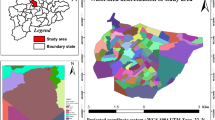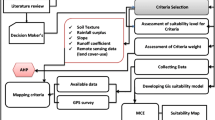Abstract
Local governments are under pressure to improve storm water management and often times must comply with consent decrees with the Federal Government. Decentralizing a portion of the storm water management by integrating private landowners into localized retention and infiltration efforts, that is, low impact development (LID) or green infrastructure projects, is becoming increasingly popular. Some wastewater systems have considered incentivizing private land owners to make improvements aimed at retaining storm water or slowing the conveyance to grey infrastructure. This study examines potential opportunities for incentivizing private residential land owners in Washington DC to install LID projects. This study maps LID configurations to a set of adoption strategies and categories. The C4.5 algorithm is then applied to identify a high performance decision tree for classifying parcels by adoption strategy or adoption categories based on property-level attributes.





Similar content being viewed by others
References
Amodeo D, Francis R (2017a) “Predicting residential low impact development adoption at the homeowner level.” Technical presentation presented at the 2017 National Capital Region water resources symposium, University of The District of Columbia, Washington DC, April 7
Amodeo D, Francis R (2017b) “Understanding Residential Low Impact Development at the Home Owner Level.” Technical Presentation presented at the INFORMS Annual Meeting 2017, Houston, Texas, October 22. Retrieved from http://meetings2.informs.org/wordpress/houston2017/schedule/
Ando AW, Freitas L (2011) Consumer demand for green stormwater management technology in an urban setting: the case of chicago rain barrels: household demand for stormwater management technology. Water Resour Res. https://doi.org/10.1029/2011WR011070
Bean EZ, William F, Hunt, Bidelspach DA (2007) “Field survey of permeable pavement surface infiltration rates.” J Irrig Drain Eng. https://doi.org/10.1061/(ASCE)07339437(2007)133%3A3(249)
Brown RR (2005) Impediments to integrated urban stormwater management: the need for institutional reform. Environ Manag 36(3):455–468. https://doi.org/10.1007/s00267-004-0217-4
Center for Watershed Protection (2013) 2013 stormwater management guidebook. Center for Watershed Protection, Washington, DC. https://doee.dc.gov/node/610622
Chandra A, Gulati S, Kandlikar M (2010) Green drivers or free riders? an analysis of tax rebates for hybrid vehicles. J Environ Econ Manag 60(2):78–93. https://doi.org/10.1016/j.jeem.2010.04.003
Department of Energy and Enviornment (2018) RiverSmart. Government of Washington DC. https://doee.dc.gov/service/get-riversmart
District of Washington, DC, Department of Enviornment (2011) DCGIS.BMPt. Government of Washington DC. http://opendata.dc.gov/datasets/best-management-practices
Francis R, Kanikicharla S, Reyes-Jones C (2012) Integrated Water Use Impact Assessment For DC Urban Infrastructure Final Report. August 2012. Retrieved from https://www.udc.edu/docs/wrri/Francis_FY2011_Final_Report.pdf
Gallagher KS, Muehlegger E (2011) Giving green to get green? incentives and consumer adoption of hybrid vehicle technology. J Environ Econ Manag 61(1):1–15. https://doi.org/10.1016/j.jeem.2010.05.004
Guo Y, Zhang S, Liu S (2014) Runoff reduction capabilities and irrigation requirements of green roofs. Water Resour Manage 28(5):1363–1378. https://doi.org/10.1007/s11269-014-0555-9
Kahn ME (2007) Do greens drive hummers or hybrids? environmental ideology as a determinant of consumer choice. J Environ Econ Manag 54(2):129–145. https://doi.org/10.1016/j.jeem.2007.05.001
Kotchen MJ, Moore MR (2008) Conservation: from voluntary restraint to a voluntary price premium. Environ Resour Econ 40(2):195–215. https://doi.org/10.1007/s10640-007-9148-x
Lawson S, Joksimovic D, Laval U, Li J, Ryerson University, Walters M, Lake Simcoe Region Cons. Auth. (2011) The perceptions of stakeholders in low impact development planning. J Water Manag Model. https://doi.org/10.14796/JWMM.R241-19.
Loáiciga HA, Majid Sadeghi K, Shivers S, Kharaghani S (2015) Stormwater control measures: optimization methods for sizing and selection. J Water Resour Plan Manag 141:04015006
McCuen R (2004) Hydrologic analysis and design, 3rd edn. Prentice Hall, Upper Saddle River
Meder A, Kouma E (2009) Low impact development for the empowered homeowner; incentive programs for single family residences. 2010, December. Retrieved from http://ebookcentral.proquest.com/lib/gwu/detail.action?docID=3115469
Montalto F, Behr C, Alfredo K, Wolf M, Arye M, Walsh M (2007) Rapid assessment of the cost-effectiveness of low impact development for CSO control. Landsc Urban Plan 82(3):117–131. https://doi.org/10.1016/j.landurbplan.2007.02.004
Porse E (2013) Stormwater governance and future cities. Water 5(1):29–52. https://doi.org/10.3390/w5010029
Quinlan JR (1993) C4.5: programs for machine learning. In The Morgan Kaufmann series in machine learning. Morgan Kaufmann Publishers, San Mateo, Calif
Sample D, Heaney J, Wright L, Koustas R (2001) Geographic information systems, decision support systems, and urban storm-water management. J Water Resour Plan Manag 127(3):155–161. https://doi.org/10.1061/(ASCE)0733-9496(2001)127:3(155)
Werff E van der, Steg L, Keizer K (2013) It is a moral issue: the relationship between environmental self-identity, obligation-based intrinsic motivation and pro-environmental behaviour. Glob Environ Change 23(5):1258–1265. https://doi.org/10.1016/j.gloenvcha.2013.07.018
Zhang S, Guo Y (2015) Analytical equation for estimating the stormwater capture efficiency of permeable pavement systems. J Irrig Drain Eng 141(4):06014004. https://doi.org/10.1061/(ASCE)IR.1943-4774.0000810
Acknowledgements
The authors acknowledge the United States National Science Foundation (NSF RIPS Project No. 1441226) for financial support of this research.
Author information
Authors and Affiliations
Corresponding author
Appendix A
Appendix A
Decision trees are methods developed for classifying observations based on both continuous and discrete attributes. Decision trees partition the data into classes based on a series of tests. Each test results in a branching of the data into either a terminal classification node, or additional test sequence. While numerous decision tree algorithms exist, the authors applied the C4.5 algorithm, developed by J.R. Quinlan (1993). The C4.5 algorithm was implemented in R using the Rweka package. Equation (1) through Eq. (4) are adopted from Quinlan (1993).
The C4.5 algorithm creates a decision tree by develo** rules based on “information gain”. This information gain is calculated by first calculating the entropy of the test set using the following Eq. (1):
Next the portion of the entropy attributable to each variable is calculated as in Eq. (2):
The gain from each variable, X, is calculated as the difference between the result for Eq. 1 for the whole training set and Eq. (2) for each variable.
The “gain ratio” is calculated by dividing the entropy of the training set (Eq. 1), by the gain associated with each variable as in Eq. (4). It is this criterion that the j48 implementation uses to determine the splitting rules.
where X is the variable being assessed and T is the multi-class data previously partitioned in Eq. (3). The gain for each variable is measured as the difference between Eq. (1) applied to a test set and the weighted entropy for each dependent variable. For example, a model with five dependent variables would entail calculating five weighted entropies.
Rights and permissions
About this article
Cite this article
Amodeo, D.C., Francis, R.A. Investigating adoption patterns of residential low impact development (LID) using classification trees. Environ Syst Decis 39, 295–306 (2019). https://doi.org/10.1007/s10669-019-09725-3
Published:
Issue Date:
DOI: https://doi.org/10.1007/s10669-019-09725-3
Keywords
- Low impact development
- Storm water retention
- Environmental policy
- Landsca**
- Decision trees
- Machine learning
- Best management practices
- Green roofs
- Combined sewage overflow
- Urban planning
- Water quality
- Storm water management
- Impervious
- Permeable
- LID
- Rain barrels
- Infiltration
- Run-off
- CSO
- Adopters, green city
- C4.5 algorithm




